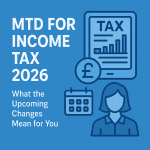
Ecommerce company bank account tips 2025 UK (Amazon, TikTok, Shopify)
October 16, 2025
MTD for Income Tax 2026: What the Upcoming Changes Mean for You
October 30, 2025Close a UK company in 2025 without losing funds by choosing the right closure route and timing. The big risks are distributing cash the wrong way (triggering extra tax) and leaving assets in the company at dissolution—when they can pass to the Crown as bona vacantia. Here’s how to close correctly and keep more of your money.
Quick answer
If you strike off a company with money or property still inside, those assets can become ownerless and pass to the Crown (bona vacantia). Extract funds and transfer assets before dissolution, or use a formal liquidation so distributions are handled correctly. See GOV.UK guidance on bona vacantia and striking off for the rules and eligibility.
Strike-off (DS01): when “cheap” can be costly
Strike-off is designed for companies that have ceased trading and settled affairs. You must meet strict eligibility rules (no recent trading, debts dealt with, etc.). If any cash, bank balance, property or IP remains at dissolution, it may pass to the Crown as bona vacantia. Always lawfully distribute cash, transfer or sell assets, then close the bank account before applying.
Tax on payouts: the £25,000 rule vs liquidation
For strike-offs (not liquidations), total distributions of up to £25,000 can be treated as capital; above that, the excess is generally taxed as income (dividends) under CTA 2010 s1030A. In a solvent Members’ Voluntary Liquidation (MVL), distributions are capital, so you may be able to claim Business Asset Disposal Relief (BADR) at 10% (subject to conditions and lifetime limit).
Solvent vs insolvent: what happens to cash and debts?
- Solvent (MVL): After paying creditors and taxes, the liquidator returns remaining cash to shareholders as capital. Often best when retained profits exceed £25,000 (potential BADR).
- Insolvent (CVL): A licensed insolvency practitioner realises assets to repay creditors by statutory priority. Employees can claim certain arrears, holiday pay and redundancy via the Insolvency Service.
Before any route, complete your final filings and tax steps: final accounts/CT600, settle Corporation Tax, and deregister VAT/PAYE where relevant.
Essential links
2025 update: dividend reporting for close companies
From 6 April 2025 (2025/26 returns), shareholders in many close companies must give more detailed dividend information on Self Assessment. Keep accurate records if paying final dividends pre-closure.
How to avoid “losing money” when you close a UK company in 2025
- Pick the right route: If retained profits are over £25k, an MVL usually delivers capital treatment (potential BADR). For small balances, a compliant strike-off may suffice.
- Empty the company before strike-off: Pay creditors, distribute cash lawfully, transfer any property or IP, then close the bank account—so nothing falls into bona vacantia.
- Finish compliance: File final accounts and CT600, settle Corporation Tax, deregister VAT/PAYE, and meet strike-off eligibility rules.
- Model after-tax outcomes: Compare income vs capital tax, BADR eligibility, and liquidation costs to maximise net returns.
So… do you “lose” business money when you close a UK company in 2025?
No—provided you extract funds correctly and choose the appropriate route. Use an MVL for larger reserves, follow HMRC rules on pre-dissolution distributions, and ensure no assets remain at dissolution to avoid bona vacantia. Done right, you can close a UK company in 2025 without handing money to the Crown or overpaying tax.
Need tailored advice? We’ll compare strike-off vs MVL outcomes, handle filings, and coordinate with a liquidator if required: Contact us.



